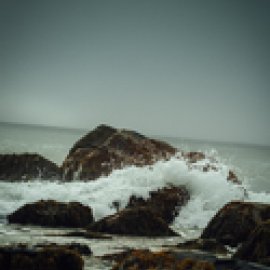RESCUE, part 17: Technology and the Ocean Pharmacopeia
-
English
-
ListenPause
[intro music]
Welcome to World Ocean Radio…
I’m Peter Neill, Director of the World Ocean Observatory.
As climate changes and temperatures rise, we are now fully aware of the melting glaciers and substantial freshwater entering the ocean in record volume. A consequence is the release of minerals, carbon, organic material, gases, microbes and bacteria, once frozen in an icy stasis, now released with inevitable change and impact for coastal and offshore ecosystems, with unknown implication for what is already an ocean under siege.
The ocean is a 70% of the earth’s surface laboratory that contains, beyond marine animals and plants, a wealth of biochemical value. Every time we poison that water or those species, we set in motion a process that we did not foresee, do not fully understand, a progress for which we are not prepared. Each element, majestically large or microscopically small, represents an opening toward decline, or an opportunity toward a discovery to be made with enormous implication for future human health. The ocean is our essential pharmacopeia.
We already know some of this value from familiar products derived from marine life and applied as pharmaceuticals: antibiotics, vitamins, enzymes, peptides, food supplements, anti-freeze, biofuels, pain-killers, and cancer treatments, all the result of our ongoing exploration of the marine environment and the ocean floor, the locus of these invaluable, inherent genetic resources. Much of this may seem invisible, but it is not, and prospect of its value is driving ocean research and discovery as never before. The World Register of Marine Species currently identifies some 240,000 known entities, each containing a compendium of knowledge and information of immense value to humankind.
Thus, the bioprospecting rush is on. The technology required to descend and collect through the water column to the ocean floor is the same, whether hunting for oil and gas, rare metals, or wonder drugs. The terrestrial genome has been explored and exhausted; exploration of the marine genome is quietly similar to a panic rush for riches. Conflicts of interest abound. The search for new oil and gas deposits may conflict with the search for lithium or cobalt for batteries for electric cars no longer dependent on fossil fuels. The search for rare metals may destroy hydrothermal vents on the sea floor, those habitats for sea creatures, chemicals, and unknown processes and inter-actions that, if synthesized, can, indeed will, revolutionize medicine, treat diseases not yet known, and extend the quality of life for all.
To date, thousands of patent applications have already been filed to capture the proprietary value of marine resources. Each patent granted is an assignment of common value to an exclusive agent for development for profit. Who approves these things? On what basis? If one application destroys the potential for another, what criteria must be applied to protect the future from the present? What can be done to protect this vast, unexplored, global, biodiversity resource from corporate condemnation and privatization?
There is emerging awareness. The deep sea mining interests have been moving quietly to capture these invisible resources, to seek permits and approvals, and to distract from the argument that this activity is urgent and necessary regardless of other consequence. The issue, however, has risen to the level of international agency and government concern. The recent Conference of Parties for the Convention of Biological Diversity has called for protections. The International Marine Protected Areas Congress argued for greater public awareness and civil society action. The French National Assembly has voted for a deep-sea mining moratorium. The Environmental Justice Foundation and Flora & Fauna International have issued reports proposing arguments against, targeted for potential investors. The Alliance of Solawara Warriors in Papua, New Guinea, have voiced the anger of the local indigenous population against industrial invasion of sacred waters. Belgium and Sweden have initiated policy reviews under the context of the UN Sustainable Development Goals. And more and more, almost daily, these questions are being asked by governments, other agencies, national and international regulatory bodies, the press, organized NGO opposition, and social media.
What is at stake here is public understanding of the full threat of these actions. It is more than remote profit-taking for narrow energy demand easily met elsewhere by alternative technology. Are we prepared to approve and permit this further attack on the ocean commons and its essential value as a place for healing and health? Or, if we are not, then will we unite to sustain the ocean pharmacopeia under the flag of RESCUE: R for renewal; E for environment; S for society; U for understanding; and E for engagement.
We will discuss these issues, and more, in future editions of World Ocean Radio.
[outro music]
This week the multi-part RESCUE series continues with an examination of familiar products derived from the ocean that we use to support our ways of life, our well-being and our health: from vitamins and supplements to pain and cancer treatments. And we discuss the future of exploration and exploitation of resources as the bio-prospecting rush heats up. How are we regulating extraction from the ocean and seafloor? Who owns the proprietary rights to marine resources, and what criteria are applied to protect biodiversity, ocean ecosystems and future resource potential to revolutionize medicine and treat disease?
RESCUE as an acronym offers a plan for specific action and public participation: Renewal, Environment, Society, Collaboration, Understanding, and Engagement.
About World Ocean Radio
5-minute weekly insights dive into ocean science, advocacy and education hosted by Peter Neill, lifelong ocean advocate and maritime expert. Episodes offer perspectives on global ocean issues and viable solutions, and celebrate exemplary projects. Available for syndicated use at no cost by college and community radio stations worldwide.
Image
Photo by Tim Foster on Unsplash
@timberfoster
- Login to post comments



